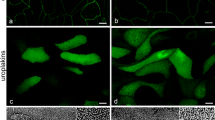Abstract
Background: Local recurrence after transurethral resection of bladder tumors (TURB) is common and might be diminished if free tumor cells within the bladder are prevented from reattaching.
Methods: In vitro inhibition of murine bladder tumor cells to an approximation of urothelial matrix with agents that might block attachment to components of the extracellular matrix, and in vivo inhibition of attachment in cautery-injured murine bladder.
Results: GRGDS, (0.1–2.5 mg/ml), a fibronectin-related peptide, mannose-6-phosphate, (0.1–20 mg/ml), a carbohydrate, and heparin (1–625 units/ml) all inhibited attachment in vitro in a dose-dependent fashion. YIGSR (0.1–2 mg/ml), a laminin-related peptide, did not. Mannose (10 mg/ml) did not significantly inhibit attachment of tumor cells to cauterized urothelium in vivo, whereas there was a 77% reduction of attachment in bladders irrigated with GRGDS (6.25 mg/ml) (p<0.05), and the appearance of subsequent tumors in the bladder was inhibited. Finally, GRGDS (6.25 mg/ml) did not inhibit healing of the cautery ulcer.
Conclusions: RGD-containing peptides may be useful as adjuvant therapy to decrease local recurrence after TURB and perhaps in other circumstances in which tumor cells spilled into a wound or body cavity threaten surgical success.
Similar content being viewed by others
References
Herr H. Transurethral resection and intravesical therapy of superficial bladder tumors.Urol Clin North Am 1991;18:525–8.
Soloway M, Masters S. Urothelial susceptibility to tumor cell implantation. Influence of cauterization.Cancer 1980;46:1158–63.
Sidransky DF, Frost P, Von Eshenbach A, Oyasu R, Preisinger A, Vogelstein B. Clonal origin of bladder cancer.N Engl J Med 1992;326:737–40.
Droller MJ. Transitional cell cancer: upper tracts and bladder. In: Walsh X, ed.Campbell's urology. Philadelphia: Saunders, 1986:1343–1408.
Grossman HB, Liebert M, Wedemeyer G, Wilson G, Flint A. Fibronectin distribution in normal and malignant urothelium.J Urol 1990;143:418–20.
Gardiner S. Immunohistochemical analysis of human bladder.Br J Urol 1989;58:19–25.
Pode D. The mechanism of human bladder tumor implantation in an in vitro model.J Urol 1986;136:482–6.
Grinnell F. Cellular adhesiveness and extracellular substrata.Int Rev Cytol 1978;58:65–129.
Soloway M. Intravesical therapy for bladder cancer.Urol Clin North Am 1988;15:661–9.
Soloway M. Intravesical and systemic chemotherapy in the management of superficial bladder cancer.Urol Clin North Am 1984;11:623–5.
Graf J, Iwamoto Y, Sasaki M, Martin G, Kleinman HK, Robey F, Yamada Y. Identification of an amino acid sequence in laminin mediating cell attachment, chemotaxis, and receptor binding.Cell 1987;48:989–96.
Iwamato Y. YIGSR, a synthetic pentapeptide, inhibits experimental metastasis formation.Science 1987;238:1132–4.
Yamada KM. Adhesive recognition sequences.J Biol Chem 1991;266:12809–12.
Springer T, Lasky L. Sticky sugars for selectins.Nature 1991;349:196–7.
Rosen SD, Yednock TA. Lymphocyte attachment to high endothelial venules during recirculation: a possible pole for carbohydrates as recognition determinants.Mol Cell Biochem 1986;72:153–64.
Krogfelt K, Bergmans H, Klemm P. Direct evidence that FIMH protein is the mannose specific adhesin ofE. coli type 1 fimbriae.Infect Immun 1990;58:1995–8.
See W, Miller J, Williams R. Pathophysiology of transitional tumor cell adherence to sites of urothelial injury in rats: mechanisms mediating intravesical recurrence due to implantation.Cancer Res 1989;49:5414–18.
See W, Chapman P. Heparin prevention of tumor cell adherence and implantation on injured urothelium surfaces.J of Urol 1987;138:182–6.
Parsons L, Mulholland SG. Antibacterial activity of bladder surface mucin duplicated by exogenous glycosaminoglycan (heparin).Infect Immun 1979;24:552–7.
Bitsch M, Hermann G, Andersen JP, Steven F. Low dose intravesical heparin as prophylaxis against recurrent noninvasive (stage Ta) baldder cancer.J Urol 1990;144:635–6.
Hynes R. Integrins: a family of cell surface receptors.Cell 1987;48:549–54.
Rajaraman R, Mac Sween C. Exogenous fibronectin requirements for adhesion by neoplastic cells.Exp Cell Biol 1983;51:9–18.
Ruoslahti E, Pierschbacher M. New perspectives in cell adhesion: RGD and integrins.Science 1987;238:491–7.
Ylanne J. RGD peptides may only temporarily inhibit cell adhesion to fibronectin.FEBS Lett 1990;267:43–5.
Humphries M, Olden K. A synthetic peptide from fibronectin inhibits experimental metastasis of murine melanoma cells.Science 1986;233:467–70.
Whalen G, Ingber D. Inhibition of tumor cell attachment to extracellular matrix as a method for preventing tumor cell recurrence in a surgical wound.Ann Surg 1989;210:758–64.
Kavoussi LR. Possible mechanism of BCG in the treatment of superficial bladder cancer.J Clin Invest 1990;85:62–7.
See W, Rohlf D, Crist S. In vitro particulate adherence to fibronectin: correlation with in vivo particulate adherence to sites of bladder injury.J Urol 1992;147:1416–23.
Author information
Authors and Affiliations
Rights and permissions
About this article
Cite this article
Hyacinthe, L.M., Jarrett, T.W., Gordon, C.S. et al. Inhibition of bladder tumor cell implantation in cauterized urothelium, without inhibition of healing, by a fibronectin-related peptide (GRGDS). Annals of Surgical Oncology 2, 450–456 (1995). https://doi.org/10.1007/BF02306380
Received:
Accepted:
Issue Date:
DOI: https://doi.org/10.1007/BF02306380




